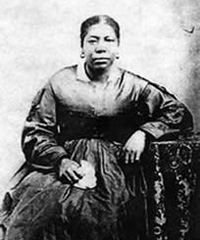
Back السود والمورمونية Arabic Schwarze im Mormonentum German Situation des Noirs dans le mormonisme French
| Black people and the Latter Day Saint movement |
|---|
 |
During the history of the Latter Day Saint movement, the relationship between Black people and Mormonism has included enslavement, exclusion and inclusion, and official and unofficial discrimination.[1]: 1–5 Black people have been involved with the Latter Day Saint movement since its inception in the 1830s.[2]: 37 Their experiences have varied widely, depending on the denomination within Mormonism and the time of their involvement.[1]: 1–5 From the mid-1800s to 1978, Mormonism's largest denomination – the Church of Jesus Christ of Latter-day Saints (LDS Church) – barred Black women and men from participating in the ordinances of its temples necessary for the highest level of salvation, and excluded most men of Black African descent from ordination in the church's lay, all-male priesthood. During that time the LDS Church also opposed interracial marriage, supported racial segregation in its communities and church schools, and taught that righteous Black people would be made white after death. The temple and priesthood racial restrictions were lifted by church leaders in 1978. In 2013, the LDS Church disavowed its previous teachings on race for the first time.
The priesthoods of most other Mormon denominations, such as the Bickertonite and Strangite churches, have always been open to members of all races. The same is true in Mormonism's second-largest denomination, the Community of Christ (formerly known as the Reorganized Church of Jesus Christ of Latter Day Saints or the RLDS), except for a few years in which Black people were barred from the priesthood. More conservative denominations, such as the Fundamentalist Church of Jesus Christ of Latter-Day Saints (FLDS), the Apostolic United Brethren (AUB), and the True and Living Church of Jesus Christ of Saints of the Last Days (TLC), continue to exclude Black people as of 2018.[3]
The LDS Church's views on Black people have alternated throughout its history. Early church leaders' views on Black slavery went from neutrality to abolitionism to a pro-slavery view. As early as 1844, church leaders taught that Black people's spirits were less righteous in premortal life (before birth). Mormonism founder Joseph Smith and his successor as church president with the most followers, Brigham Young, both taught that the skin color of Black people was the result of the curses of Cain and Ham. During the 20th century, many LDS leaders opposed the civil rights movement. In recent decades, the church has condemned racism and increased its outreach efforts in Black communities. It is still accused of perpetuating implicit racism by not apologizing for, acknowledging, or adequately counteracting the effects of its past beliefs and discriminatory practices like segregation.[4]: 7 Church leaders have worked with the National Association for the Advancement of Colored People (the NAACP) since the 2010s, and have donated millions of dollars to Black organizations.[5]
There are an estimated 400,000 to one million Black LDS Church members worldwide, and at least five LDS Church temples in Africa. Fourteen more temples are at some stage of development or construction on the continent, in addition to several temples among communities of the African diaspora such as the Dominican Republic and Haiti. The Community of Christ has congregations in twelve African nations, with membership increasing.[6]
- ^ a b Cite error: The named reference
Harris2015was invoked but never defined (see the help page). - ^ Cite error: The named reference
Saints, Slaves, and Blackswas invoked but never defined (see the help page). - ^ Carlisle, Nate (May 26, 2018). "Right after the Mormon church gave blacks the priesthood, a polygamous offshoot saw its ranks grow". The Salt Lake Tribune.
- ^ Cite error: The named reference
Black and mormonwas invoked but never defined (see the help page). - ^ Fletcher Stack, Peggy (June 14, 2021). "'Transformational partnership' – LDS Church donating nearly $10M to help Black Americans". The Salt Lake Tribune. Archived from the original on February 15, 2023 – via Internet Archive.
- ^ Cite error: The named reference
Increasingwas invoked but never defined (see the help page).